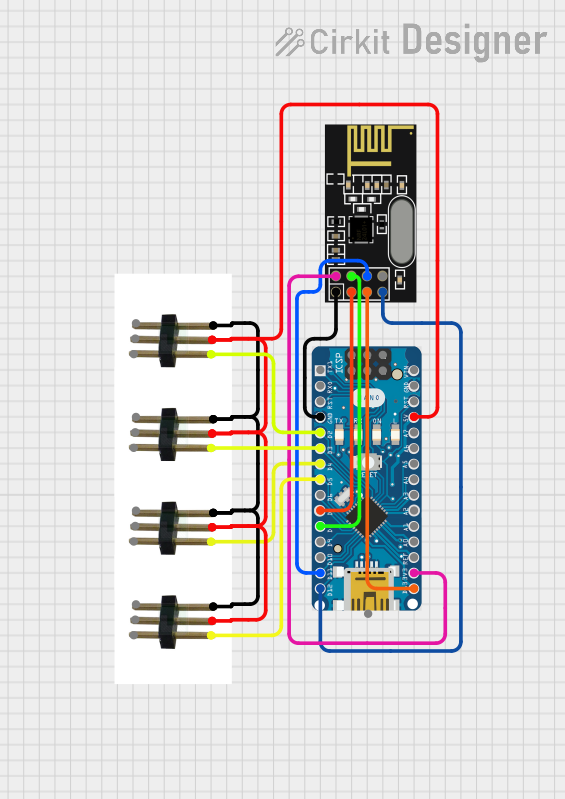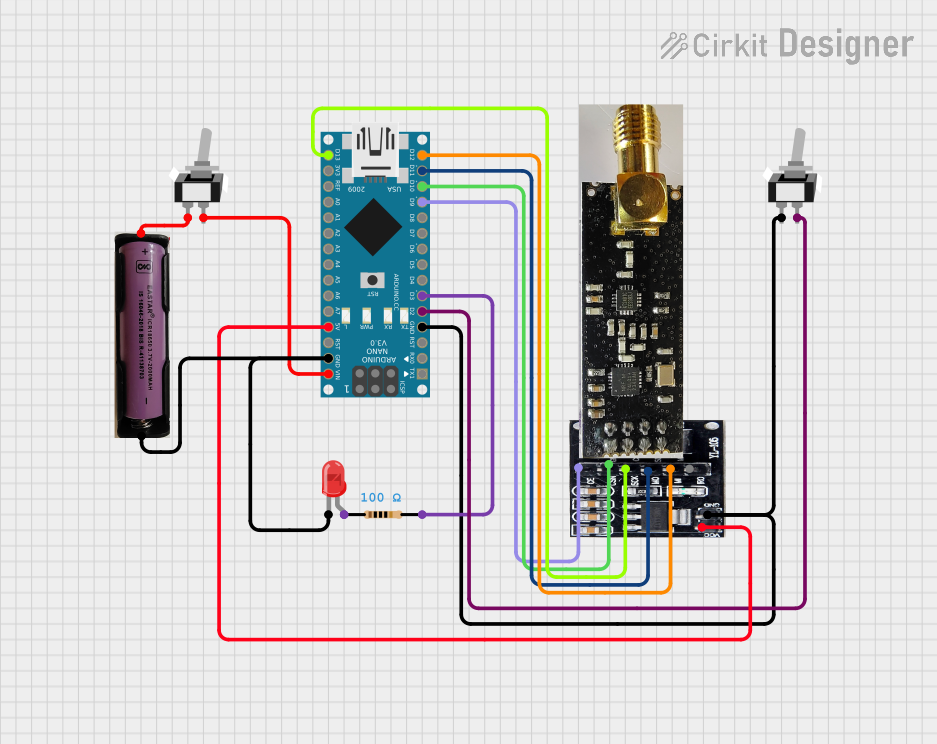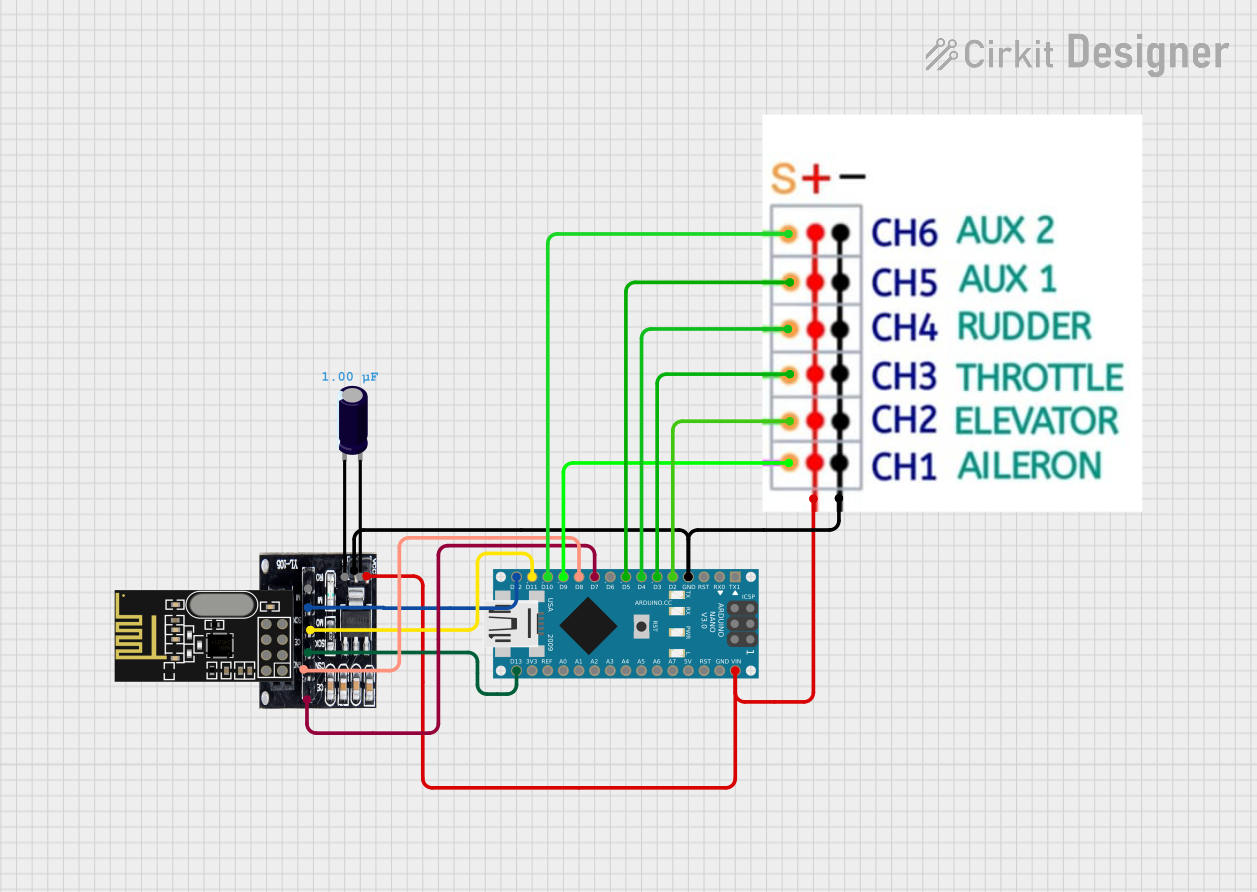
How to Use nrf24l01+pa+lna : Examples, Pinouts, and Specs

 Design with nrf24l01+pa+lna in Cirkit Designer
Design with nrf24l01+pa+lna in Cirkit DesignerIntroduction
The nRF24L01+PA+LNA is a low-power, 2.4 GHz transceiver module manufactured by Pra. It features an integrated Power Amplifier (PA) and Low-Noise Amplifier (LNA), which significantly enhance its range and sensitivity compared to the standard nRF24L01 module. This module is widely used in wireless communication applications, including remote controls, IoT devices, wireless sensors, and home automation systems.
Explore Projects Built with nrf24l01+pa+lna

 Open Project in Cirkit Designer
Open Project in Cirkit Designer
 Open Project in Cirkit Designer
Open Project in Cirkit Designer
 Open Project in Cirkit Designer
Open Project in Cirkit Designer
 Open Project in Cirkit Designer
Open Project in Cirkit DesignerExplore Projects Built with nrf24l01+pa+lna

 Open Project in Cirkit Designer
Open Project in Cirkit Designer
 Open Project in Cirkit Designer
Open Project in Cirkit Designer
 Open Project in Cirkit Designer
Open Project in Cirkit Designer
 Open Project in Cirkit Designer
Open Project in Cirkit DesignerCommon Applications
- Wireless data transmission in IoT devices
- Remote control systems (e.g., drones, RC cars)
- Wireless sensor networks
- Home automation and smart devices
- Industrial monitoring and control systems
Technical Specifications
The following table outlines the key technical details of the nRF24L01+PA+LNA module:
| Parameter | Value |
|---|---|
| Operating Frequency | 2.4 GHz ISM Band |
| Operating Voltage | 1.9V to 3.6V |
| Recommended Voltage | 3.3V |
| Maximum Data Rate | 2 Mbps |
| Output Power | Up to +20 dBm (adjustable) |
| Sensitivity | -96 dBm at 1 Mbps |
| Communication Protocol | SPI |
| Range (Line of Sight) | Up to 1,000 meters (with PA/LNA) |
| Operating Temperature | -40°C to +85°C |
| Current Consumption | 115 mA (transmit mode, max power) |
Pin Configuration and Descriptions
The nRF24L01+PA+LNA module has an 8-pin interface. The pinout and descriptions are as follows:
| Pin | Name | Description |
|---|---|---|
| 1 | GND | Ground connection |
| 2 | VCC | Power supply (1.9V to 3.6V, typically 3.3V) |
| 3 | CE | Chip Enable: Activates the module for transmission or reception |
| 4 | CSN | Chip Select Not: SPI chip select (active low) |
| 5 | SCK | Serial Clock: SPI clock input |
| 6 | MOSI | Master Out Slave In: SPI data input |
| 7 | MISO | Master In Slave Out: SPI data output |
| 8 | IRQ | Interrupt Request: Indicates data received or transmission complete (optional) |
Usage Instructions
How to Use the nRF24L01+PA+LNA in a Circuit
- Power Supply: Connect the VCC pin to a 3.3V power source. Do not connect it directly to 5V, as this may damage the module. Use a 3.3V regulator if your system operates at 5V.
- SPI Interface: Connect the SPI pins (CSN, SCK, MOSI, MISO) to the corresponding SPI pins on your microcontroller.
- CE Pin: Use a GPIO pin on your microcontroller to control the CE pin. Set it high to enable the module for transmission or reception.
- IRQ Pin: Optionally, connect the IRQ pin to a GPIO pin on your microcontroller to handle interrupts for events like data reception or transmission completion.
- Antenna: Ensure the external antenna is securely connected to the SMA connector for optimal performance.
Important Considerations and Best Practices
- Decoupling Capacitor: Place a 10 µF capacitor close to the VCC and GND pins to stabilize the power supply.
- Level Shifting: If your microcontroller operates at 5V logic, use a level shifter to interface with the module's 3.3V logic.
- Antenna Placement: Position the antenna away from metal objects and other sources of interference for maximum range.
- Library Support: Use libraries like the RF24 library for Arduino to simplify communication with the module.
Example Code for Arduino UNO
Below is an example of how to use the nRF24L01+PA+LNA module with an Arduino UNO to send and receive data:
#include <SPI.h>
#include <nRF24L01.h>
#include <RF24.h>
// Define CE and CSN pins for the nRF24L01+ module
#define CE_PIN 9
#define CSN_PIN 10
// Create an RF24 object
RF24 radio(CE_PIN, CSN_PIN);
// Define the address for communication
const byte address[6] = "00001";
void setup() {
Serial.begin(9600); // Initialize serial communication
radio.begin(); // Initialize the nRF24L01+ module
radio.openWritingPipe(address); // Set the address for transmission
radio.setPALevel(RF24_PA_HIGH); // Set power amplifier level
radio.stopListening(); // Set module to transmit mode
}
void loop() {
const char text[] = "Hello, World!"; // Data to send
bool success = radio.write(&text, sizeof(text)); // Send data
if (success) {
Serial.println("Data sent successfully!");
} else {
Serial.println("Data transmission failed.");
}
delay(1000); // Wait 1 second before sending again
}
Notes:
- Install the RF24 library in your Arduino IDE before using the code.
- Adjust the CE and CSN pin definitions if you use different GPIO pins.
Troubleshooting and FAQs
Common Issues and Solutions
Module Not Responding:
- Ensure the module is powered with 3.3V and not 5V.
- Check all connections, especially SPI pins, for proper wiring.
Short Range or No Signal:
- Verify that the antenna is securely connected.
- Avoid placing the module near sources of interference, such as Wi-Fi routers or metal objects.
Data Transmission Fails:
- Ensure the CE pin is set high during transmission.
- Verify that both the transmitter and receiver use the same address and data rate.
High Current Consumption:
- Use a stable 3.3V power supply capable of providing at least 200 mA.
- Add a decoupling capacitor (10 µF) near the module's VCC and GND pins.
FAQs
Q: Can I use the nRF24L01+PA+LNA with a 5V microcontroller?
A: Yes, but you must use a 3.3V regulator for the power supply and level shifters for the SPI pins.
Q: What is the maximum range of the module?
A: The module can achieve up to 1,000 meters of range in line-of-sight conditions with a proper antenna.
Q: How do I improve signal strength?
A: Use a high-gain antenna, ensure proper antenna placement, and minimize interference from other devices.
Q: Can I use multiple modules in a network?
A: Yes, the nRF24L01+PA+LNA supports multi-node communication using unique addresses for each module.